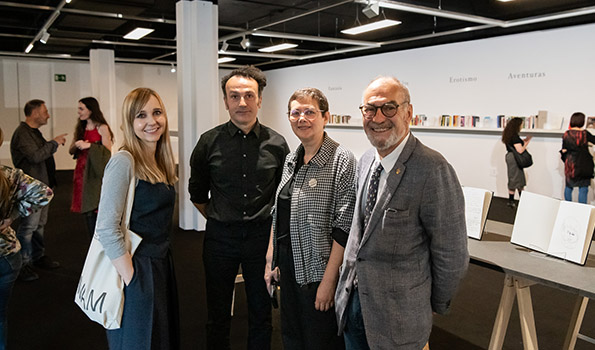'I will not die completely'
David Maroto promotes the memory of his family's tragic history in an exhibition that reinforces the growing concept of the artist's novel
[ 19/05/2025 ]
"The novel deals with several aspects... but the main one is the extrajudicial execution of my grandfather Manuel during the Spanish Civil War. He is still in a mass grave, and although I have spent years trying to open it, identify his body, exhume it and reburial it alongside his wife, my grandmother Manuela, this has proved impossible. I don't know why, but I haven't been able to. I've tried everything, from the Ministry to the Town Hall (of Valdepeñas), the association of relatives of victims of that grave... no one wants to open it," explains David Maroto, a visual artist with a degree from the Faculty of Fine Arts at the UPV, a PhD from the Edinburgh College of Art and currently based in the Netherlands.
'At the same time,' he adds, 'the motivation to write this novel began on 17 April 2020, when my mother, Manuel's daughter, died of COVID. I don't have any children, and then I realised I am the last one left. When I die, all these people I care so much about will disappear with me because their memory, which is the only thing that remains alive, will die with me.'
This is the seed of 'No es un concepto, sino una historia' (It's not a concept, but a story), the exhibition that Espai n-1 at the Central Library of the Vera Campus of the Universitat Politècnica de València (UPV) is hosting until 13 June with free admission.
The Book Lovers
The exhibition, divided into two parts, features 'The Book Lovers', the artistic research project carried out since 2011 by Maroto himself and art historian, writer, performer and curator Joanna Zielinska, a collection and bibliography of artist novels, unique in their genre, which has been acquired by the Museum of Contemporary Art in Antwerp and generously loaned for this exhibition.
'There wasn't even a bibliography of artist novels,' says Maroto, 'and we have found 687 worldwide to date. They now belong to the Museum of Contemporary Art in Antwerp. I ask to purchase two copies of each artist's novel we find, one to remain in the museum and the other to be circulated in exhibitions such as the one we have here now.'
What is an artist's novel?
'An artist's novel is not a novel written by an artist,' says Maroto. 'These are cases in which a visual artist creates a novel that makes more sense within an artistic discourse than a literary one. The ambition is not to write a novel, but to introduce notions traditionally associated with literature into an artistic practice.'
The artistic novel, which emerged in the 1990s and is constantly on the rise, 'is understood as a medium within the visual arts, like video, performance or installations, rather than a literary genre'.
'I don't go to a printer because no one can guarantee that the copies will be read'
For the exhibition itself, Maroto has put together a team of performers so that each visitor, if they wish, can listen to readings of selected passages from the novels on display, including his own artist's novel, No moriré por completo (I Will Not Die Completely), created to share and preserve his family's history.
"I don't go to a printing press. I could have done that and made 500 copies, but that wouldn't have guaranteed anyone would read them. What I do is give each interested person a blank book and a pen identical to the ones I used. Then, for more than five hours, I dictate the content of the novel, which they write down, creating their own copy, which they keep. In this case, in the performance in which 12 people participated on 8 May, we asked them to lend it to us temporarily for the exhibition. This way, they will never forget the story."
Death, memory, writing and the desire for posterity
Alongside Maroto's own artist's novel, this second part of the exhibition features creations inspired by it. 'The writing process gives me ideas that expand beyond the page. That's why this exhibition includes drawings, sculptures, murals... all of which emanate from the narrative of the work.'
In any case, the project has a clear starting point, 'the connection between writing and memory and the desire for posterity, in the sense of overcoming oblivion, of transcending biological limits, beyond death, to have a kind of continuity, a non-biological existence in the form of memory, which is the only form of eternal life allowed to human beings.'
Carlos Ayats Pérez / UPV Communication Area
Outstanding news
 The Diamond Army
The Diamond Army
Two students came up with the UPV initiative that has engaged more than 1,600 volunteers and shattered the false myth of the 'crystal generation'
 ARWU 2024
ARWU 2024
The Shanghai ranking reaffirms the UPV as the best polytechnic in Spain for yet another year
 Distinction of the Generalitat for Scientific Merit
Distinction of the Generalitat for Scientific Merit
Guanter has been distinguished in recognition of his research excellence in the development of satellite methods for environmental applications
 The new statutes come into force
The new statutes come into force
The Universitat Politècnica de València is the first university in Spain with statutes adapted to the new LOSU
 NanoNIR project against breast cancer
NanoNIR project against breast cancer
UPV Researcher Carla Arnau del Valle receives an EU Marie Curie grant to develop biosensors for the early detection of this cancer
 Large artificial intelligence language models, increasingly unreliable
Large artificial intelligence language models, increasingly unreliable
According to a study by the Universitat Politècnica de València, ValgrAI and the University of Cambridge, published in the journal Nature





